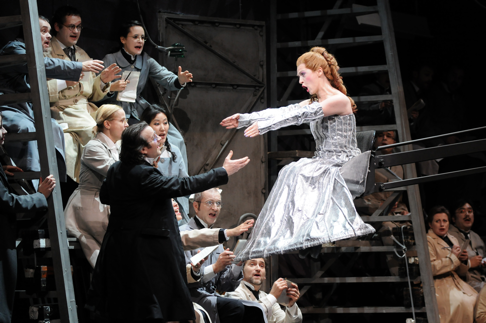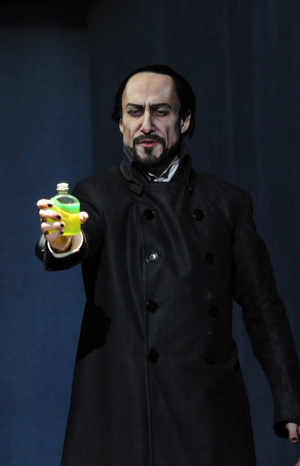![John Osborn as Hoffmann [Photo © Jean-Pierre Maurin]](http://www.operatoday.com/Hoffmann_Lyon2_OT.png)
07 Jan 2014
Les Contes d'Hoffmann in Lyon
Maybe there can be no bigger feat than making it through Les Contes d’Hoffmann in the Laurent Pelly version without a hitch or two.
English Touring Opera are delighted to announce a season of lyric monodramas to tour nationally from October to December. The season features music for solo singer and piano by Argento, Britten, Tippett and Shostakovich with a bold and inventive approach to making opera during social distancing.
This tenth of ten Live from London concerts was in fact a recorded live performance from California. It was no less enjoyable for that, and it was also uplifting to learn that this wasn’t in fact the ‘last’ LfL event that we will be able to enjoy, courtesy of VOCES8 and their fellow vocal ensembles (more below …).
Ever since Wigmore Hall announced their superb series of autumn concerts, all streamed live and available free of charge, I’d been looking forward to this song recital by Ian Bostridge and Imogen Cooper.
Although Stile Antico’s programme article for their Live from London recital introduced their selection from the many treasures of the English Renaissance in the context of the theological debates and upheavals of the Tudor and Elizabethan years, their performance was more evocative of private chamber music than of public liturgy.
Evidently, face masks don’t stifle appreciative “Bravo!”s. And, reducing audience numbers doesn’t lower the volume of such acclamations. For, the audience at Wigmore Hall gave soprano Elizabeth Llewellyn and pianist Simon Lepper a greatly deserved warm reception and hearty response following this lunchtime recital of late-Romantic song.
For this week’s Live from London vocal recital we moved from the home of VOCES8, St Anne and St Agnes in the City of London, to Kings Place, where The Sixteen - who have been associate artists at the venue for some time - presented a programme of music and words bound together by the theme of ‘reflection’.
'Such is your divine Disposation that both you excellently understand, and royally entertaine the Exercise of Musicke.’
‘And there was war in heaven: Michael and his angels fought against the dragon; and the dragon fought and his angels, And prevailed not; neither was their place found any more in heaven … that old serpent … Satan, which deceiveth the whole world: he was cast out into the earth, and his angels were cast out with him.’
There was never any doubt that the fifth of the twelve Met Stars Live in Concert broadcasts was going to be a palpably intense and vivid event, as well as a musically stunning and theatrically enervating experience.
‘Love’ was the theme for this Live from London performance by Apollo5. Given the complexity and diversity of that human emotion, and Apollo5’s reputation for versatility and diverse repertoire, ranging from Renaissance choral music to jazz, from contemporary classical works to popular song, it was no surprise that their programme spanned 500 years and several musical styles.
The Academy of St Martin in the Fields have titled their autumn series of eight concerts - which are taking place at 5pm and 7.30pm on two Saturdays each month at their home venue in Trafalgar Square, and being filmed for streaming the following Thursday - ‘re:connect’.
The London Symphony Orchestra opened their Autumn 2020 season with a homage to Oliver Knussen, who died at the age of 66 in July 2018. The programme traced a national musical lineage through the twentieth century, from Britten to Knussen, on to Mark-Anthony Turnage, and entwining the LSO and Rattle too.
With the Live from London digital vocal festival entering the second half of the series, the festival’s host, VOCES8, returned to their home at St Annes and St Agnes in the City of London to present a sequence of ‘Choral Dances’ - vocal music inspired by dance, embracing diverse genres from the Renaissance madrigal to swing jazz.
Just a few unison string wriggles from the opening of Mozart’s overture to Le nozze di Figaro are enough to make any opera-lover perch on the edge of their seat, in excited anticipation of the drama in music to come, so there could be no other curtain-raiser for this Gala Concert at the Royal Opera House, the latest instalment from ‘their House’ to ‘our houses’.
"Before the ending of the day, creator of all things, we pray that, with your accustomed mercy, you may watch over us."
The doors at The Metropolitan Opera will not open to live audiences until 2021 at the earliest, and the likelihood of normal operatic life resuming in cities around the world looks but a distant dream at present. But, while we may not be invited from our homes into the opera house for some time yet, with its free daily screenings of past productions and its pay-per-view Met Stars Live in Concert series, the Met continues to bring opera into our homes.
Music-making at this year’s Grange Festival Opera may have fallen silent in June and July, but the country house and extensive grounds of The Grange provided an ideal setting for a weekend of twelve specially conceived ‘promenade’ performances encompassing music and dance.
There’s a “slide of harmony” and “all the bones leave your body at that moment and you collapse to the floor, it’s so extraordinary.”
“Music for a while, shall all your cares beguile.”
The hum of bees rising from myriad scented blooms; gentle strains of birdsong; the cheerful chatter of picnickers beside a still lake; decorous thwacks of leather on willow; song and music floating through the warm evening air.
![John Osborn as Hoffmann [Photo © Jean-Pierre Maurin]](http://www.operatoday.com/Hoffmann_Lyon2_OT.png)
Maybe there can be no bigger feat than making it through Les Contes d’Hoffmann in the Laurent Pelly version without a hitch or two.
There were in fact two just now in the Opéra de Lyon remounting of its 2005 production of Hoffmann, both collective hitches.
Not only has Mr. Pelly created a figurative nightmare, he has created a technical nightmare as well. The usual four sets — the tavern, the workshop, the bedroom, the salon — morph into thirty or forty or so scenes, a seemingly countless progression of scenic moments that evolve through the unfolding of Hoffmann’s narration in dream form. And the dream is a bad one in which the macabre surreal is suspended in abstract, dark space.
The Pelly concept is complex indeed. Not for a moment does Pelly allow us to forget that human motivations push the bizarre psychological and philosophical impulses of E.T.A. Hoffmann’s morbid tales. He accomplishes this by making us watch smart, strong stagehands push and pull walls and platforms and operate machines that transport Pelly’s phantoms through the dream world he has created for Offenbach’s opera.
 John Osborn as Hoffmann, Patrizia Ciofi as Olimpia. Photo © Jean-Pierre Maurin
John Osborn as Hoffmann, Patrizia Ciofi as Olimpia. Photo © Jean-Pierre Maurin
Offenbach never lets up on his teasing of the world of art — E.T.A. Hoffmann was a poet, Offenbach’s Hoffmann is a poet and singer, Stella is a singer, etc. Pelly and his brilliant scenographer Chantal Thomas have created a production that is continuous creation, and like the roles of Hoffmann and Stella in all her transfigurations — roles that demand great virtuosity and superhuman strength — their production teases the art of stagecraft by teetering it on the edge of what mechanical stagecraft can possibly achieve.
The efforts of mind and muscle expended to operate its scenic mechanism are enormous, and amazingly and precisely timed to messieurs Offenbach and Hoffmann. But in a real dream all this movement would seem effortless, even magical. It did not quite work that way just now in Lyon — there were occasional thumps, pounding now and again, walls chasing singers, platforms that jerked their way across the stage. The production simply does not sit comfortably within the confines of architect Jean Nouvel’s theater.
But you can imagine that when this production does move effortlessly it easily becomes the star of the show. The production was reborn last year in Barcelona and San Francisco before returning now to Lyon. In San Francisco it achieved, more or less, the smoothness of a dream (though there were still technical glitches) and it was in fact the star of the show. However the star was supposed to be Natalie Dessay who finally sang only Antonia (appropriately and ironically the iconic French diva announced her retirement from the opera stage after the second performance).
Of course the name of the opera is Hoffmann thus the star of the show should be Hoffmann. In fact in Lyon American tenor John Osborn achieves the artistic stature to fulfill the demands of Laurent Pelly’s concept, and hold the stage vocally and histrionically through this monumental competition. Mr. Osborn is a very physical performer, a real actor and a beautifully voiced, finished singer. Vocally he is a tenore leggero allowing him to negotiate the role’s high tessitura with ease, maybe even interpolate a few high notes for added effect. At the end however when we expect the pathos of an emotionally and vocally exhausted Hoffmann Mr. Osborn sounded like he could take it from the top all over again.
The Pelly production begins with Stella alone onstage singing Mozart's “Non mi dir” from Don Giovanni. It was Italian diva Patrizia Ciofi, an esteemed artist who quite resembles Natalie Dessay, in what seems to be her role debut as Stella. It was easy to forgive this bit of wobbly Mozart, harder to forgive the wooden tones of Olimpia with truncated high notes, painful to hear the hoarse sounds of her lower voice as Antonia, and irritating to perceive her struggling tiredness as Giulietta. Though dramaturgically Offenbach’s Tales may beg a single opera star to fulfill an impossible array of voices, this example vindicates casting three different singers who can compete vocally with Hoffmann himself, not to mention a conceptually demanding production.
 Laurant Alvaro as Dr. Miracle. Photo © Jean-Pierre Maurin
Laurant Alvaro as Dr. Miracle. Photo © Jean-Pierre Maurin
French bass-baritone Laurent Alvaro made big voiced, sinister villains, moving through the roles with force and aplomb though he does not exude a vocal, musical or histrionic refinement that rises to the sophistication of the Pelly production. The same may be said of young Cyrille Dubois as the four servants. Belgian mezzo-soprano Angélique Noldus was over-parted as Nicklausse, neither her voice nor her persona able to cross over the pit into the auditorium. The roles of Luther and Crespel were clumsily executed by British baritone Peter Sidhom.
Offenbach’s score is one of opera’s most engaging masterpieces. But even the pit could not save this performance. This sixth performance (of eight) was conducted by Philippe Forget (Kazushi Ono conducted the first four). This young French maestro conducts minor projects at the Opéra de Lyon and elsewhere. While the Lyon orchestra ably fulfilled its role and the maestro and singers were comfortable with one another, the wit, power and pathos of the score were sorely lacking. Perhaps the young maestro was unnerved by the roughness of the production and its singers.
Michael Milenski
For additional perspective on this production please see Les Contes d’Hoffmann in San Francisco
Casts and production information:
Hoffmann: John Osborn; Lindorf/Coppelius/Docteur Miracle/Dapertutto: Laurent Alvaro; Olympia/Antonia/Giulietta/Stella: Patrizia Ciofi; Muse/Nicklausse: Angélique Noldus; Andrès/Cochenille/Frantz/Pitichinaccio: Cyrille Dubois; Hermann/Peter Schlemil: Christophe Gay; Nathanaël/Spalanzani: Carl Ghazarossian. Chorus and Orchestra of the Opéra de Lyon. Conductor: Philippe Forget. Mise en scène and costumes: Laurent Pelly; Scenery: Chantal Thomas; Lighting: Joël Adam. Opéra Nouvel de Lyon. December 26, 2013.